Fuzzy Logic Modeling of Land Degradation in a Loess Plateau Watershed, China
Abstract
1. Introduction
2. Materials and Methods
2.1. Study Area
2.2. Data Sources
2.3. Fuzzy Logic Modeling of Land Degradation Assessment System
2.3.1. Dominant Land Degradation Processes
- Vegetation degradation
- 2.
- Soil erosion
- 3.
- Aridity
- 4.
- Loss of soil organic carbon
- 5.
- Desertification
2.3.2. Fuzzification
2.3.3. Fuzzy Rule Inference
2.3.4. Defuzzification
3. Results
3.1. Changes in Vegetation Cover and Land Use
3.2. Soil Erosion Rate Changes
3.3. Land Degradation Changes
4. Discussion
4.1. Land Degradation Assessment
4.2. Causes of Land Degradation Changes
5. Conclusions
Author Contributions
Funding
Data Availability Statement
Acknowledgments
Conflicts of Interest
References
- Keith, H.; Vardon, M.; Stein, J.A.; Stein, J.L.; Lindenmayer, D. Ecosystem accounts define explicit and spatial trade-offs for managing natural resources. Nat. Ecol. Evol. 2017, 1, 1683–1692. [Google Scholar] [CrossRef] [PubMed]
- Yang, C.; Li, Q.; Chen, J.; Wang, J.J.; Shi, T.Z.; Hu, Z.W.; Ding, K.; Wang, G.H.; Wu, G.F. Spatiotemporal characteristics of land degradation in the Fuxian Lake Basin, China: Past and future. Land Degrad. Dev. 2020, 31, 2446–2460. [Google Scholar] [CrossRef]
- Kust, G.; Andreeva, O.; Cowie, A. Land degradation neutrality: Concept development, practical applications and assessment. J. Environ. Manag. 2017, 195, 16–24. [Google Scholar] [CrossRef] [PubMed]
- UNCCD. United Nations Convention to Combat Desertification—Global Land Outlook, 1st ed.; UNCCD Secretariat: Bonn, Germany, 2017; Available online: http://refhub.elsevier.com/S0012-8252(21)00190-2/rf2255 (accessed on 8 March 2022).
- Gisladottir, G.; Stocking, M. Land degradation control and its global environmental benefits. Land Degrad. Dev. 2005, 16, 99–112. [Google Scholar] [CrossRef]
- Hurni, H.; Giger, M.; Liniger, H.; Studer, R.M.; Messerli, P.; Portner, B.; Schwilch, G.; Wolfgramm, B.; Breu, T. Soils, agriculture and food security: The interplay between ecosystem functioning and human well-being. Curr. Opin. Environ. Sustain. 2015, 15, 25–34. [Google Scholar] [CrossRef]
- IPBES. Intergovernmental Science-Policy Platform on Biodiversity and Ecosystem Services—The Assessment Report on Land Degradation and Restoration; Summary for Policymakers; IPBES Secretariat: Bonn, Germany, 2018; Available online: http://refhub.elsevier.com/S0012-8252(21)00190-2/rf0905 (accessed on 20 February 2022).
- Von Braun, J.; Gerber, N.; Mirzabaev, A.; Nkonya, E. The Economics of Land Degradation; ZEF Working Paper No. 109; Elsevier: Amsterdam, The Netherlands, 2013. [Google Scholar] [CrossRef]
- Costanza, R.; de Groot, R.; Sutton, P.C.; van der Ploeg, S.; Anderson, S.; Kubiszewski, I.; Farber, S.; Turner, R.K. Changes in the global value of ecosystem services. Glob. Environ. 2014, 26, 152–158. [Google Scholar] [CrossRef]
- Prăvălie, R. Exploring the multiple land degradation pathways across the planet. Earth-Sci. Rev. 2021, 220, 103689. [Google Scholar] [CrossRef]
- Masoudi, M.; Elhaeesahar, M.; Cerdà, A. Risk Assessment of Land Degradation (RALDE) in Khuzestan Province, Iran. Eurasian Soil Sc. 2021, 54, 1228–1240. [Google Scholar] [CrossRef]
- Akinyemi, F.O.; Tlhalerwa, L.T.; Eze, P.N. Land degradation assessment in an African dryland context based on the Composite Land Degradation Index and mapping method. Geocarto Int. 2019, 36, 1838–1854. [Google Scholar] [CrossRef]
- Turner, K.G.; Anderson, S.; Gonzales-Chang, M.; Costanza, R.; Courville, S.; Dalgaard, T.; Dominati, E.; Kubiszewski, I.; Ogilvy, S.; Porfirio, L.; et al. A review of methods, data, and models to assess changes in the value of ecosystem services from land degradation and restoration. Ecol. Model. 2016, 319, 190–207. [Google Scholar] [CrossRef]
- Geist, H.J.; Lambin, E.F. Dynamic causal patterns of desertification. Bioscience 2004, 54, 817–829. [Google Scholar] [CrossRef]
- Mbow, C.; Brandt, M.; Ouedraogo, I.; De Leeuw, J.; Marshall, M. What four decades of earth observation tell us about land degradation in the Sahel? Remote Sens. 2015, 7, 4048–4067. [Google Scholar] [CrossRef]
- Vicenteserrano, S.; Cabello, D.; Tomás-Burguera, M.; MartínHernández, N.; Beguería, S.; Azorin-Molina, C.; Kenawy, A. Drought variability and land degradation in semiarid regions: Assessment using remote sensing data and drought indices (1982–2011). Remote Sens. 2015, 7, 4391–4423. [Google Scholar] [CrossRef]
- Fiorillo, E.; Maselli, F.; Tarchiani, V.; Vignaroli, P. Analysis of land degradation processes on a tiger bush plateau in south West Niger using MODIS and LANDSAT TM/ETM+ data. Int. J. Appl. Earth Obs. Geoinf. 2017, 62, 56–68. [Google Scholar] [CrossRef]
- Ajaj, Q.M.; Pradhan, B.; Noori, A.M.; Jebur, M.N. Spatial monitoring of desertification extent in western Iraq using LANDSAT images and GIS. Land Degrad. Dev. 2017, 28, 10–37. [Google Scholar] [CrossRef]
- Curtis, P.G.; Slay, C.M.; Harris, N.L.; Tyukavina, A.; Hansen, M.C. Classifying drivers of global forest loss. Science 2018, 361, 1108–1111. [Google Scholar] [CrossRef]
- Zhang, Y.; Degroote, J.; Wolter, C.; Sugumaran, R. Integration of modified universal soil loss equation (MUSLE) into a GIS framework to assess soil erosion risk. Land Degrad. Dev. 2009, 20, 84–91. [Google Scholar] [CrossRef]
- Borrelli, P.; Panagos, P.; Ballabio, C.; Lugato, E.; Weynants, M.; Montanarella, L. Towards a pan-European assessment of land susceptibility to wind erosion. Land Degrad. Dev. 2016, 27, 1093–1105. [Google Scholar] [CrossRef]
- Feng, L.; Jia, Z.; Li, Q.; Zhao, A.; Zhang, Z.; Zhao, Y. Spatiotemporal change of aeolian desertification land distribution in northern China from 2001 to 2015. J. Indian Soc. Remote Sens. 2018, 46, 1555–1561. [Google Scholar] [CrossRef]
- Yang, M.; Nelson, F.E.; Shiklomanov, N.I.; Guo, D.; Wan, G. Permafrost degradation and its environmental effects on the Tibetan Plateau: A review of recent research. Earth-Sci. Rev. 2010, 103, 31–44. [Google Scholar] [CrossRef]
- Jiang, L.; Jiapaer, G.; Bao, A.; Li, Y.; Guo, H.; Zheng, G.; Chen, T.; De Maeyer, P. Assessing land degradation and quantifying its drivers in the Amudarya River delta. Ecol. Indic. 2019, 107, 105595. [Google Scholar] [CrossRef]
- Romshoo, S.A.; Amin, M.; Sastry, K.L.N.; Parmar, M. Integration of social, economic and environmental factors in GIS for land degradation vulnerability assessment in the Pir Panjal Himalaya, Kashmir, India. Appl. Geogr. 2020, 125, 102307. [Google Scholar] [CrossRef]
- Feng, Q.; Chaubey, I.; Engel, B.; Cibin, R.; Sudheer, K.P.; Volenec, J. Marginal land suitability for switchgrass, Miscanthus and hybrid poplar in the Upper Mississippi River Basin (UMRB). Environ. Model. Softw. 2017, 93, 356–365. [Google Scholar] [CrossRef]
- Cai, X.; Zhang, X.; Wang, D. Land availability for biofuel production. Environ. Sci. Technol.-Columb. 2011, 45, 334. [Google Scholar] [CrossRef] [PubMed]
- Lewis, S.M.; Fitts, G.; Kelly, M.; Dale, L. A fuzzy logic-based spatial suitability model for drought-tolerant switchgrass in the United States. Comput. Electron. Agric. 2014, 103, 39–47. [Google Scholar] [CrossRef]
- İnci, D.T.; Orhan, D.; Barış, Ö. Spatial assessment and mapping of soil quality index for desertification in the semi-arid terrestrial ecosystem using MCDM in interval type-2 fuzzy environment. Comput. Electron. Agric. 2019, 164, 104933. [Google Scholar] [CrossRef]
- Tafreshi, G.M.; Nakhaei, M.; Lak, R. Land subsidence risk assessment using GIS fuzzy logic spatial modeling in Varamin aquifer, Iran. GeoJournal 2021, 86, 1203–1223. [Google Scholar] [CrossRef]
- Fu, B.; Wang, S.; Liu, Y.; Liu, J.; Liang, W.; Miao, C. Hydrogeomorphic ecosystem responses to natural and anthropogenic changes in the Loess Plateau of China. Annu. Rev. Earth Planet. Sci. 2017, 45, 223–243. [Google Scholar] [CrossRef]
- Zhao, G.J.; Kondolf, G.M.; Mu, X.M.; Han, M.W.; He, Z.; Rubin, Z.; Wang, F.; Gao, P.; Sun, W.Y. Sediment yield reduction associated with land use changes and check dams in a catchment of the Loess Plateau, China. Catena 2017, 148, 126–137. [Google Scholar] [CrossRef]
- Zhang, B.; He, C.; Burnham, M.; Zhang, L. Evaluating the coupling effects of climate aridity and vegetation restoration on soil erosion over the Loess Plateau in China. Sci. Total Environ. 2016, 539, 436–449. [Google Scholar] [CrossRef]
- Wang, H.; Zhang, G.H.; Li, N.N.; Zhang, B.J.; Yang, H.Y. Soil erodibility influenced by natural restoration time of abandoned farmland on the Loess Plateau of China. Geoderma 2018, 325, 18–27. [Google Scholar] [CrossRef]
- Feng, X.; Fu, B.; Piao, S.; Wang, S.; Ciais, P.; Zeng, Z.; Li, Y.; Jiang, X.; Wu, B. Revegetation in China’s Loess Plateau is approaching sustainable water resource limits. Nat. Clim. Chang. 2016, 6, 1019–1022. [Google Scholar] [CrossRef]
- Li, J.; Peng, S.; Li, Z. Detectingand attributing vegetation changes on China’s Loess Plateau. Agric. For. Meteorol. 2017, 247, 260–270. [Google Scholar] [CrossRef]
- Wang, S.; Fu, B.; Piao, S.; Lü, Y.; Ciais, P.; Feng, X.; Wang, Y. Reduced sediment transport in the Yellow River due to anthropogenic changes. Nat. Geosci. 2016, 9, 38–41. [Google Scholar] [CrossRef]
- Wen, X.; Deng, X.Z. Current soil erosion assessment in the Loess Plateau of China: A mini-review. J. Clean. Prod. 2020, 276, 123091. [Google Scholar] [CrossRef]
- Zhao, G.J.; Gao, P.; Tian, P.; Sun, W.Y.; Hu, J.F.; Mu, X.M. Assessing sediment connectivity and soil erosion by water in a representative catchment on the Loess Plateau, China. Catena 2020, 185, 104284. [Google Scholar] [CrossRef]
- Li, P.F.; Chen, J.N.; Zhao, G.J.; Holden, J.; Liu, B.T.; Chan, F.K.S.; Hu, J.F.; Wu, P.L.; Mu, X.M. Determining the drivers and rates of soil erosion on the Loess Plateau since 1901. Sci. Total Environ. 2022, 823, 153674. [Google Scholar] [CrossRef]
- Wang, Z.; Xu, M.; Liu, X.; Singh, D.K.; Fu, X. Quantifying the impact of climate change and anthropogenic activities on runoff and sediment load reduction in a typical Loess Plateau watershed. J. Hydrol.-Reg. Stud. 2022, 39, 100992. [Google Scholar] [CrossRef]
- Tian, P.; Zhao, G.J.; Mu, X.M.; Wang, F.; Mi, Z.J. Check Dam Identification Using Multisource Data and Their Effects on Streamflow and Sediment Load in a Chinese Loess Plateau Catchment. J. Appl. Remote Sens. 2013, 7, 073697. [Google Scholar] [CrossRef]
- Shi, H.; Li, T.; Wang, K.; Zhang, A.; Wang, G.; Fu, X. Physically based simulation of the streamflow decrease caused by sediment-trapping dams in the middle Yellow River. Hydrol. Process 2016, 30, 783–794. [Google Scholar] [CrossRef]
- Zhao, G.J.; Klik, A.; Mu, X.M.; Wang, F.; Gao, P.; Sun, W.Y. Sediment yield estimation in a small watershed on the northern Loess Plateau, China. Geomorphology 2015, 241, 343–352. [Google Scholar] [CrossRef]
- Xu, X.L.; Liu, J.Y.; Zhang, S.W.; Li, R.D.; Yan, C.Z.; Wu, S.X. China Multi-period Land Use and Land Cover Change Remote Sensing Monitoring Dataset (CNLUCC). In Data Registration and Publishing System of Resource and Environment Science Data Center; Chinese Academy of Sciences: Beijing, China, 2018. [Google Scholar] [CrossRef]
- Olsson, L.; Barbosa, H.; Bhadwal, S.; Cowie, A.; Delusca, K.; Flores-Renteria, D.; Hermans, K.; Jobbagy, E.; Kurz, W.; Li, D.; et al. Land degradation. In Climate Change and Land: An IPCC Special Report on Climate Change, Desertification, Land Degradation, Sustainable Land Management, Food Security, and Greenhouse Gas Fluxes in Terrestrial Ecosystems; 2019; in press; Available online: http://refhub.elsevier.com/S0012-8252(21)00190-2/rf1570 (accessed on 15 March 2022).
- Yu, Y.; Zhao, W.W.; Martinez-Murillo, J.F.; Pereira, P. Loess Plateau: From degradation to restoration. Sci. Total Environ. 2020, 738, 140206. [Google Scholar] [CrossRef] [PubMed]
- Gutaman, G.; Ignatov, A. The derivation of the green vegetation fraction from NOAA/A VHRR data for use in numerical weather prediction models. Int. J. Remote Sens. 1998, 19, 1533–1543. [Google Scholar] [CrossRef]
- Renard, K.G.; Foster, G.R.; Weesies, G.A.; McCool, D.K.; Yoder, D.C. Predicting Soil Erosion by Water: A Guide to Conservation Planning with the Revised Universal Soil Loss Equation (RUSLE); US Government Printing Office: Washington, DC, USA, 1997.
- Zhang, W.B.; Xie, Y.; Liu, B.Y. Rainfall erosivity estimation using daily rainfall amounts. Sci. Geogr. Sin. 2002, 22, 705–711. Available online: http://refhub.elsevier.com/S0341-8162(16)30180-1/rf0250 (accessed on 25 February 2022). (In Chinese with English abstract).
- Wischmeier, W.H.; Smith, D.D. Predicting Rainfall Erosion Losses—A Guide to Conservation Planning; Department of Agriculture, Science and Education Administration: Washington, DC, USA, 1978. Available online: https://handle.nal.usda.gov/10113/CAT79706928 (accessed on 18 March 2022).
- Liu, B.Y.; Xie, Y.; Li, Z.G.; Liang, Y.; Zhang, W.B.; Fu, S.H.; Yin, S.Q.; Wei, X.; Zhang, K.L.; Wang, Z.Q.; et al. The assessment of soil loss by water erosion in China. Int. Soil Water Conserv. Res. 2020, 8, 430–439. [Google Scholar] [CrossRef]
- Swarnkar, S.; Malini, A.; Tripathi, S.; Sinha, R. Assessment of uncertainties in soil erosion and sediment yield estimates at ungauged basins: An application to the Garra River basin, India. Hydrol. Earth Syst. Sci. 2018, 22, 2471–2485. [Google Scholar] [CrossRef]
- Allen, R.G.; Pereira, L.S.; Raes, D.; Smith, M. Crop Evapotranspiration: Guidelines for Computing Crop Water Requirements; Irrigation and Drainage Paper No 56; Food and Agriculture Organization of the United Nations (FAO): Rome, Italy, 1998. [Google Scholar]
- Kögel-Knabner, I.; Amelung, W. Soil organic matter in major pedogenic soil groups. Geoderma 2021, 384, 114785. [Google Scholar] [CrossRef]
- Prăvălie, R.; Patriche, C.; Borrelli, P.; Panagos, P.; Roșca, B.; Dumitraşcu, M.; Nita, I.A.; Săvulescu, I.; Dumitraşcu, M.-V.; Bandoc, G. Arable lands under the pressure of multiple land degradation processes. A global perspective. Environ. Res. 2021, 194, 110697. [Google Scholar] [CrossRef]
- Nelson, D.W.; Sommers, L.E. Total Carbon, Organic Carbon and Organic Matter; Agronomy Monograph No. 9.; SSSA: Madison, WI, USA, 1982; pp. 534–580. [Google Scholar] [CrossRef]
- Oberthü, R.T.; Dobermann, A.; Aylward, M. Using auxiliary information to adjust fuzzy membership functions for improved mapping of soil qualities. Int. J. Geogr. Inf. Sci. 2000, 14, 431–454. [Google Scholar] [CrossRef]
- Reshmidevi, T.V.; Eldho, T.I.; Jana, R. A GIS-integrated fuzzy rule-based inference system for land suitability evaluation in agricultural watersheds. Agric. Syst. 2009, 101, 101–109. [Google Scholar] [CrossRef]
- Elsheikh, R.; Mohamed Shariff, A.R.B.; Amiri, F.; Ahmad, N.B.; Balasundram, S.K.; Soom, M.A.M. Agriculture Land Suitability Evaluator (ALSE): A decision and planning support tool for tropical and subtropical crops. Comput. Electron. Agric. 2013, 93, 98–110. [Google Scholar] [CrossRef]
- Liu, S.; Zamanian, K.; Schleuss, P.; Zarebanadkouki, M.; Kuzyakov, Y. Degradation of Tibetan grasslands: Consequences for carbon and nutrient cycles. Agric. Ecosyst. Environ. 2018, 252, 93–104. [Google Scholar] [CrossRef]
- Kooch, Y.; Amani, M.; Abedi, M. Vegetation degradation threatens soil health in a mountainous semi-arid region. Sci. Total Environ. 2022, 830, 154827. [Google Scholar] [CrossRef] [PubMed]
- Sartori, M.; Philippidis, G.; Ferrari, E.; Borrelli, P.; Lugato, E.; Montanarella, L.; Panagos, P. A linkage between the biophysical and the economic: Assessing the global market impacts of soil erosion. Land Use Policy 2019, 86, 299–312. [Google Scholar] [CrossRef]
- Prăvălie, R. Drylands extent and environmental issues. A global approach. Earth Sci. Rev. 2016, 161, 259–278. [Google Scholar] [CrossRef]
- UNESCO. Map of the world distribution of arid regions: Explanatory note. In MAP Technical Notes 7; UNESCO: Paris, France, 1979; p. 54. [Google Scholar]
- Gregory, A.S.; Ritz, K.; McGrath, S.P.; Quinton, J.N.; Goulding, K.W.T.; Jones, R.J.A.; Harris, J.A.; Bol, R.; Wallace, P.; Pilgrim, E.S.; et al. A review of the impacts of degradation threats on soil properties in the UK. Soil Use Manag. 2015, 31, 1–15. [Google Scholar] [CrossRef]
- Lorenz, K.; Lal, R.; Ehlers, K. Soil organic carbon stock as an indicator for monitoring land and soil degradation in relation to United Nations’ Sustainable Development Goals. Land Degrad. Dev. 2019, 30, 824–838. [Google Scholar] [CrossRef]
- Liu, B.Y.; Nearing, M.A.; Shi, P.J.; Jia, Z.W. Slope length effects on soil loss for steep slopes. Soil Sci. Soc. Am. J. 2000, 64, 1759–1763. [Google Scholar] [CrossRef]
- Panagos, P.; Borrelli, P.; Meusburger, C.; Alewell, C.; Lugato, E.; Montanarella, L. Estimating the soil erosion cover-management factor at European scale. Land Use Policy J. 2015, 48, 38–50. [Google Scholar] [CrossRef]
- Borrelli, P.; Robinson, D.A.; Panagos, P.; Lugato, E.; Yang, J.E.; Alewell, C.; Wuepper, D.; Montanarella, L.; Ballabio, C. Land use and climate change impacts on global soil erosion by water (2015–2070). Proc. Natl. Acad. Sci. USA 2020, 117, 21994–22001. [Google Scholar] [CrossRef]
- Wang, Y.; Brandt, M.; Zhao, M.; Tong, X.; Xing, K.; Xue, F.; Kang, M.; Wang, L.; Jiang, Y.; Fensholt, R. Major forest increase on the Loess Plateau, China (2001–2016). Land Degrad. Dev. 2018, 29, 4080–4091. [Google Scholar] [CrossRef]
- Jiang, C.; Zhang, H.; Wang, X.; Feng, Y.; Labzovskii, L. Challenging the land degradation in China’s Loess Plateau: Benefits, limitations, sustainability, and adaptive strategies of soil and water conservation. Ecol. Eng. 2019, 127, 135–150. [Google Scholar] [CrossRef]
- Ge, J.; Pitman, A.J.; Guo, W.; Zan, B.; Fu, C. Impact of revegetation of the Loess Plateau of China on the regional growing season water balance. Hydrol. Earth Syst. Sci. 2020, 24, 515–533. [Google Scholar] [CrossRef]
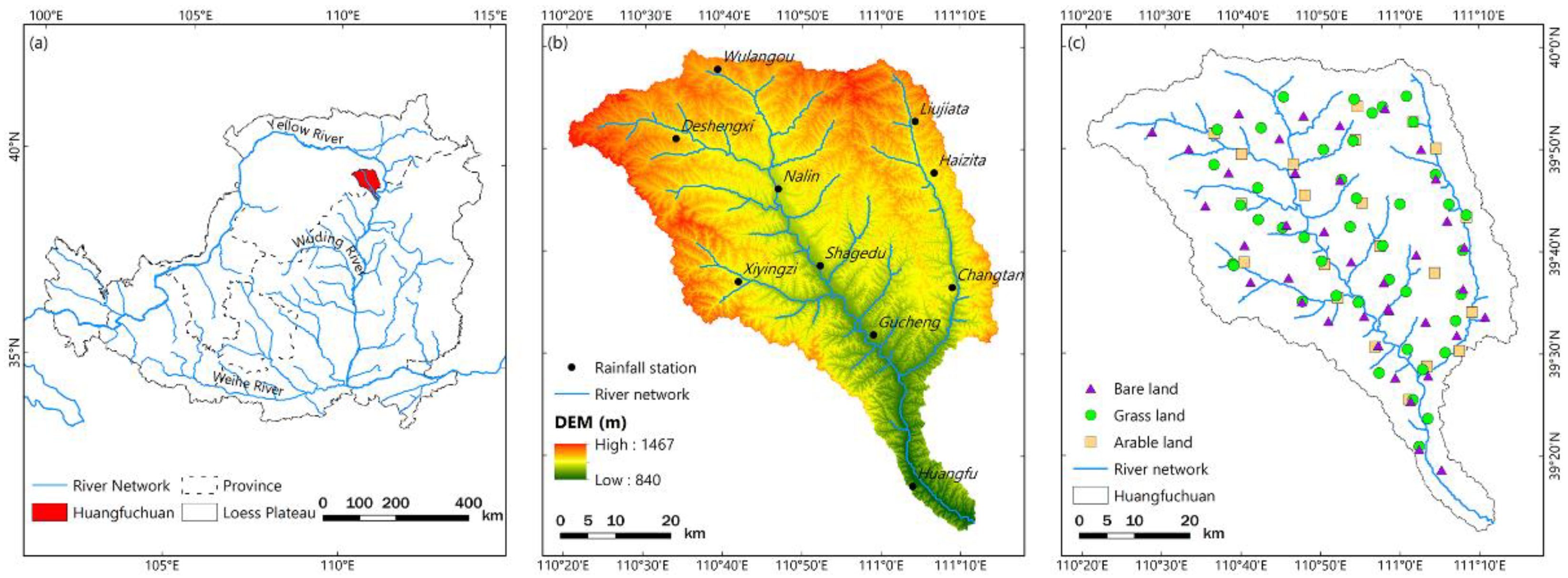
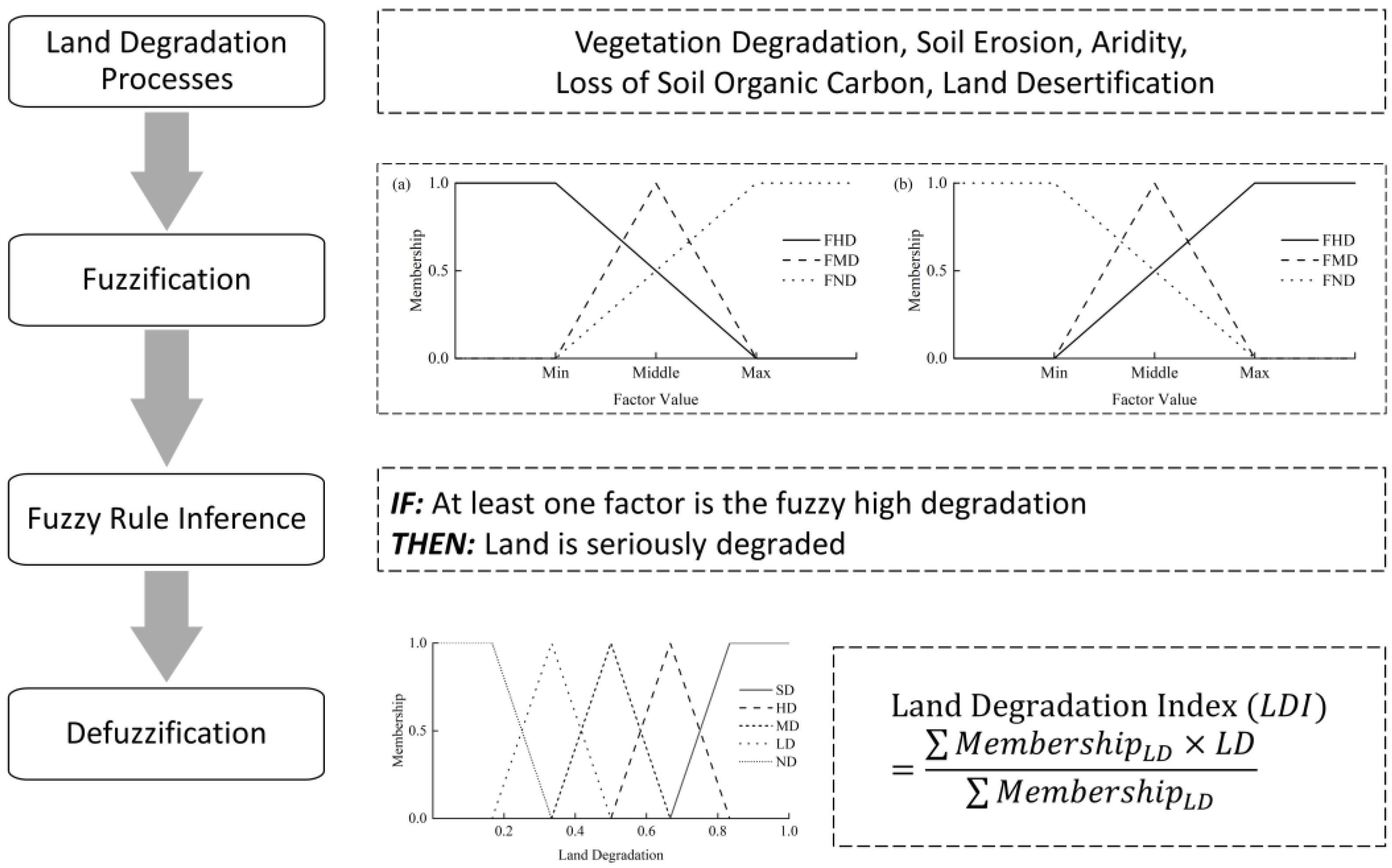
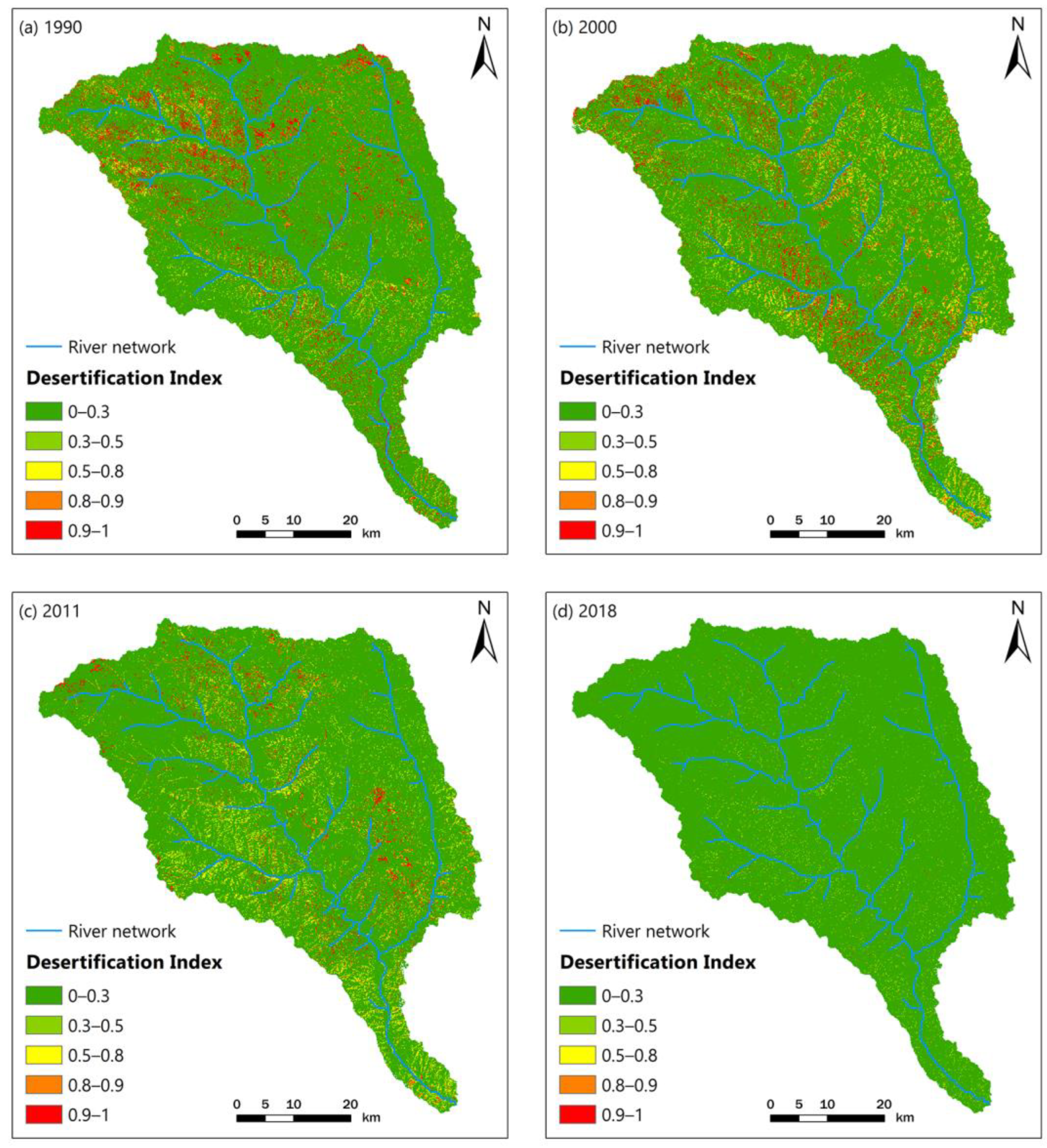

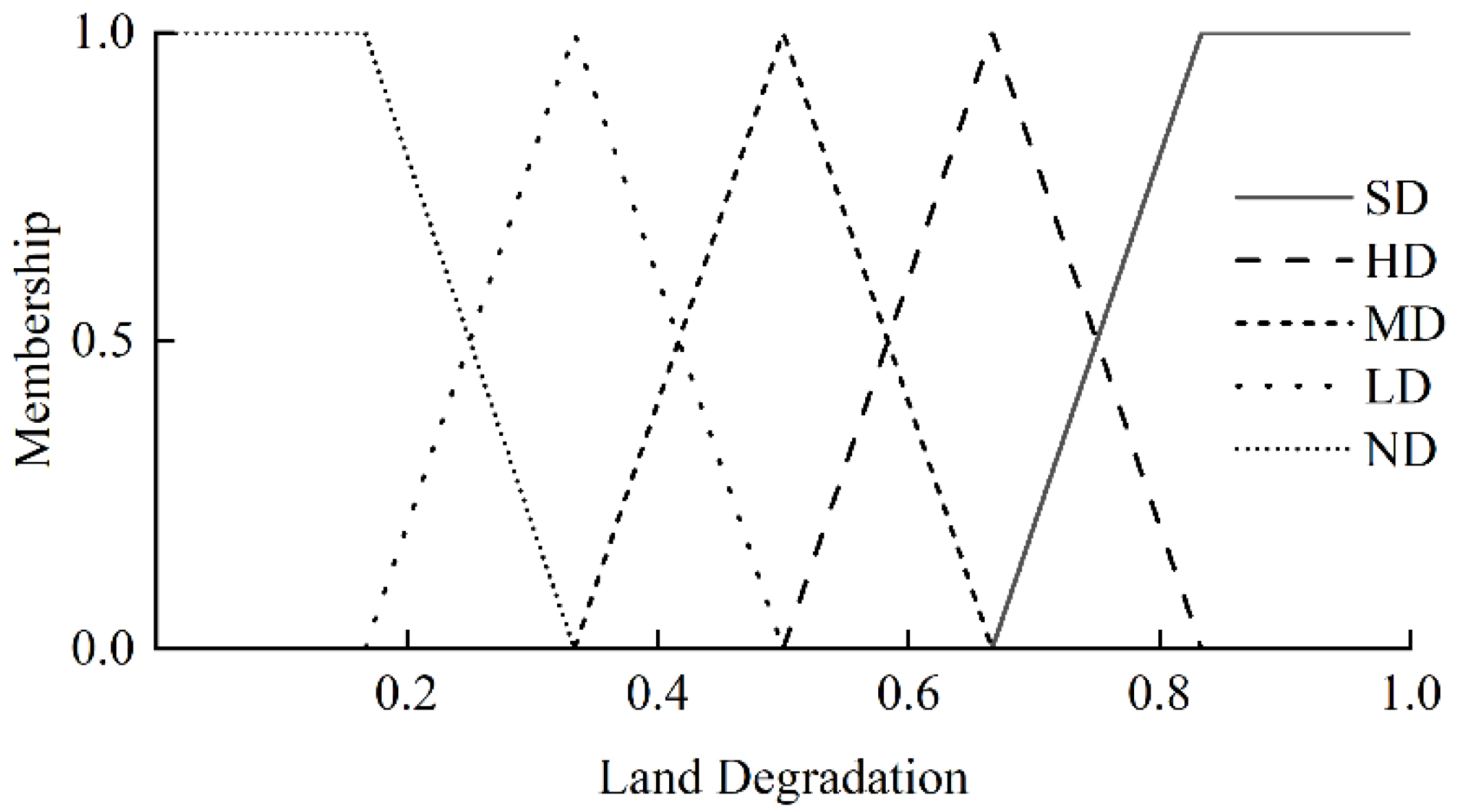
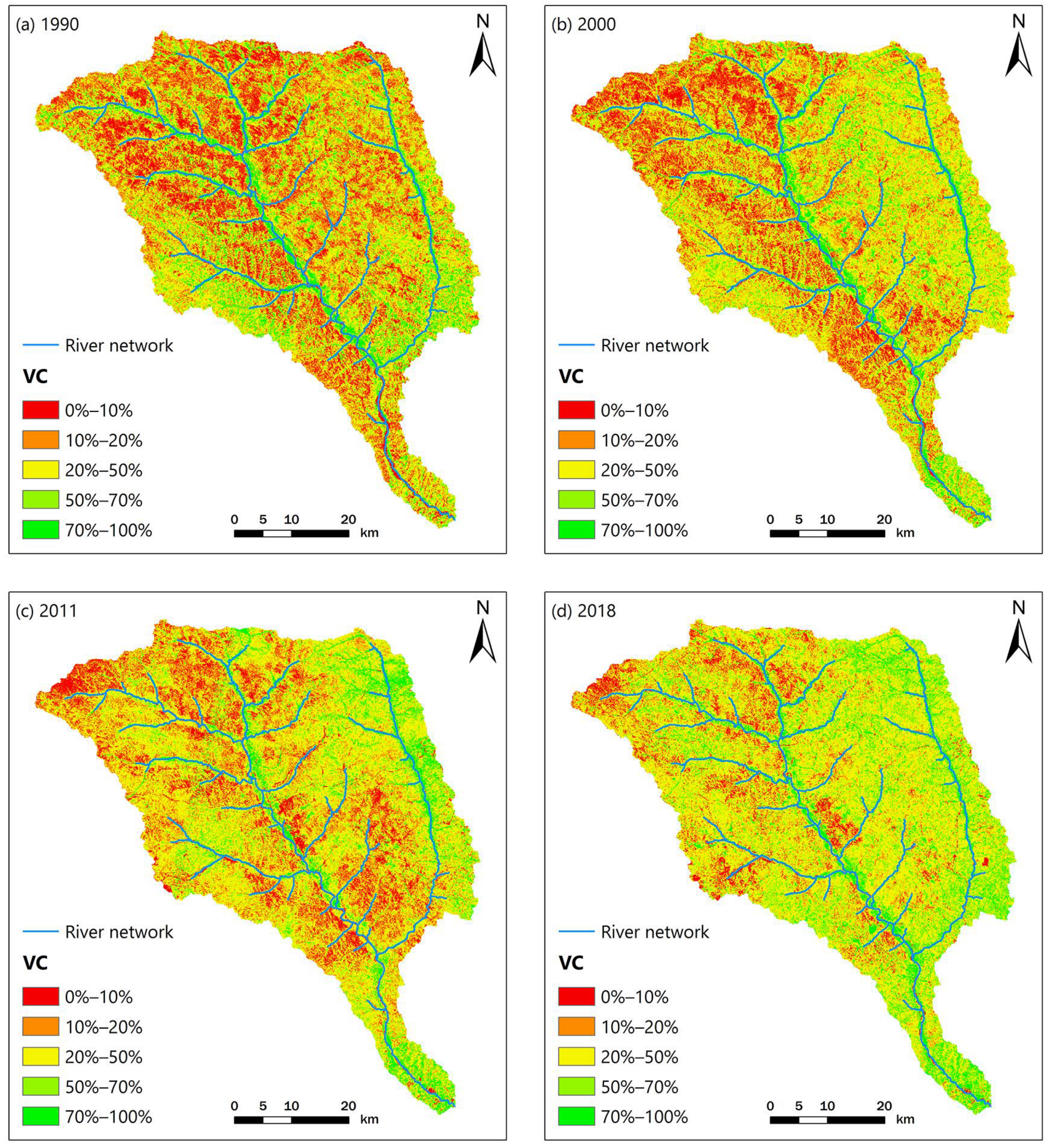

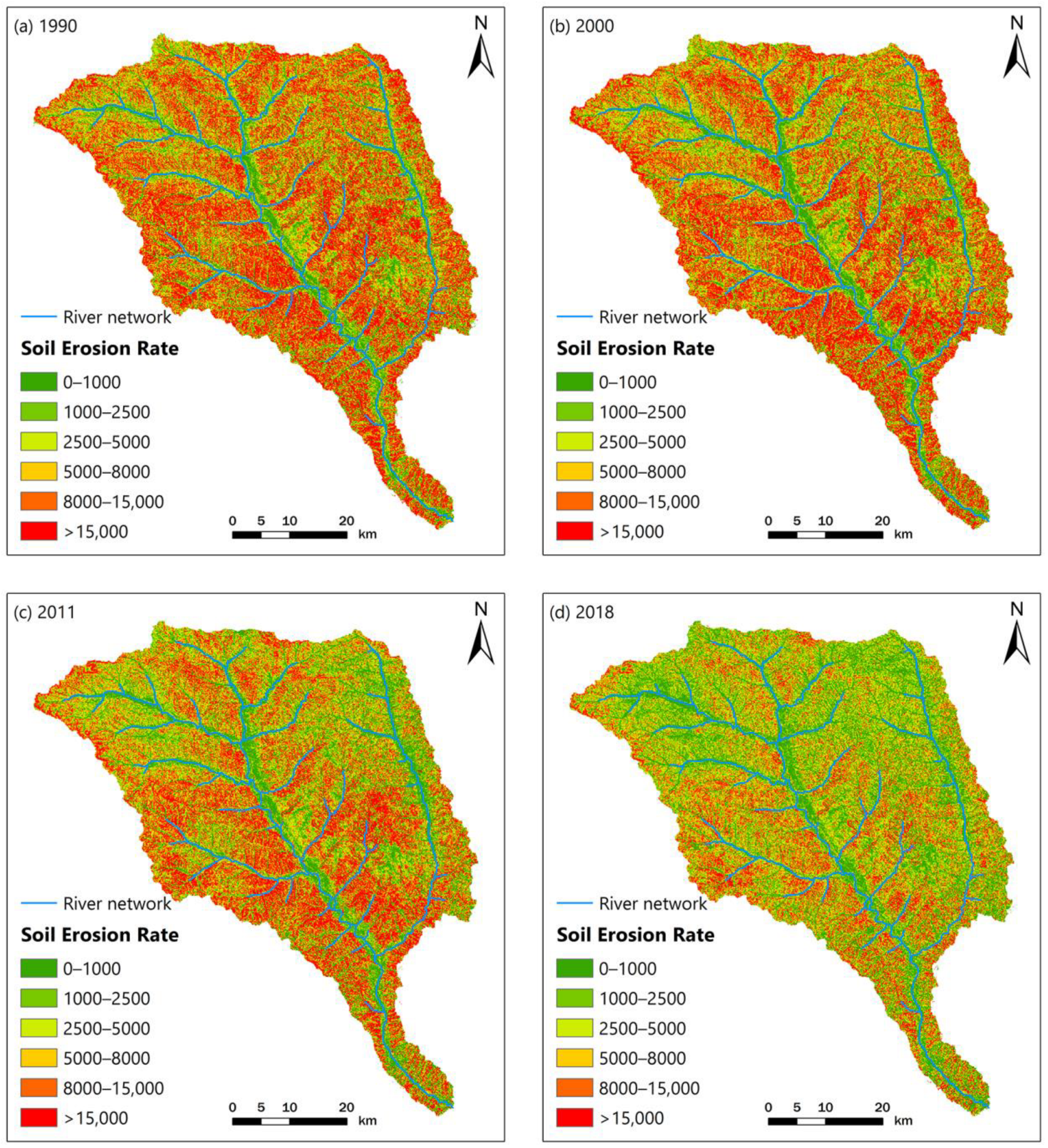
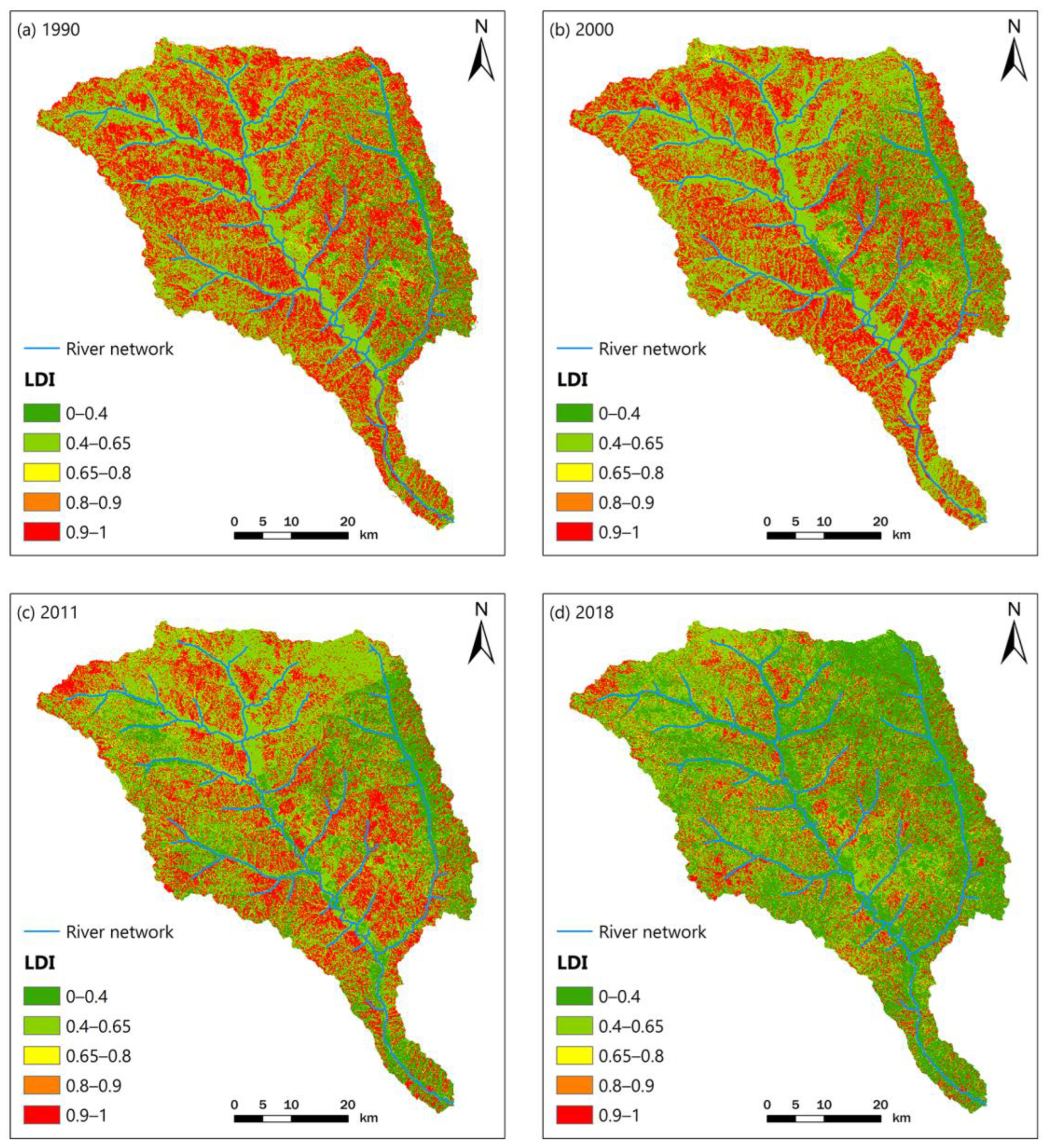
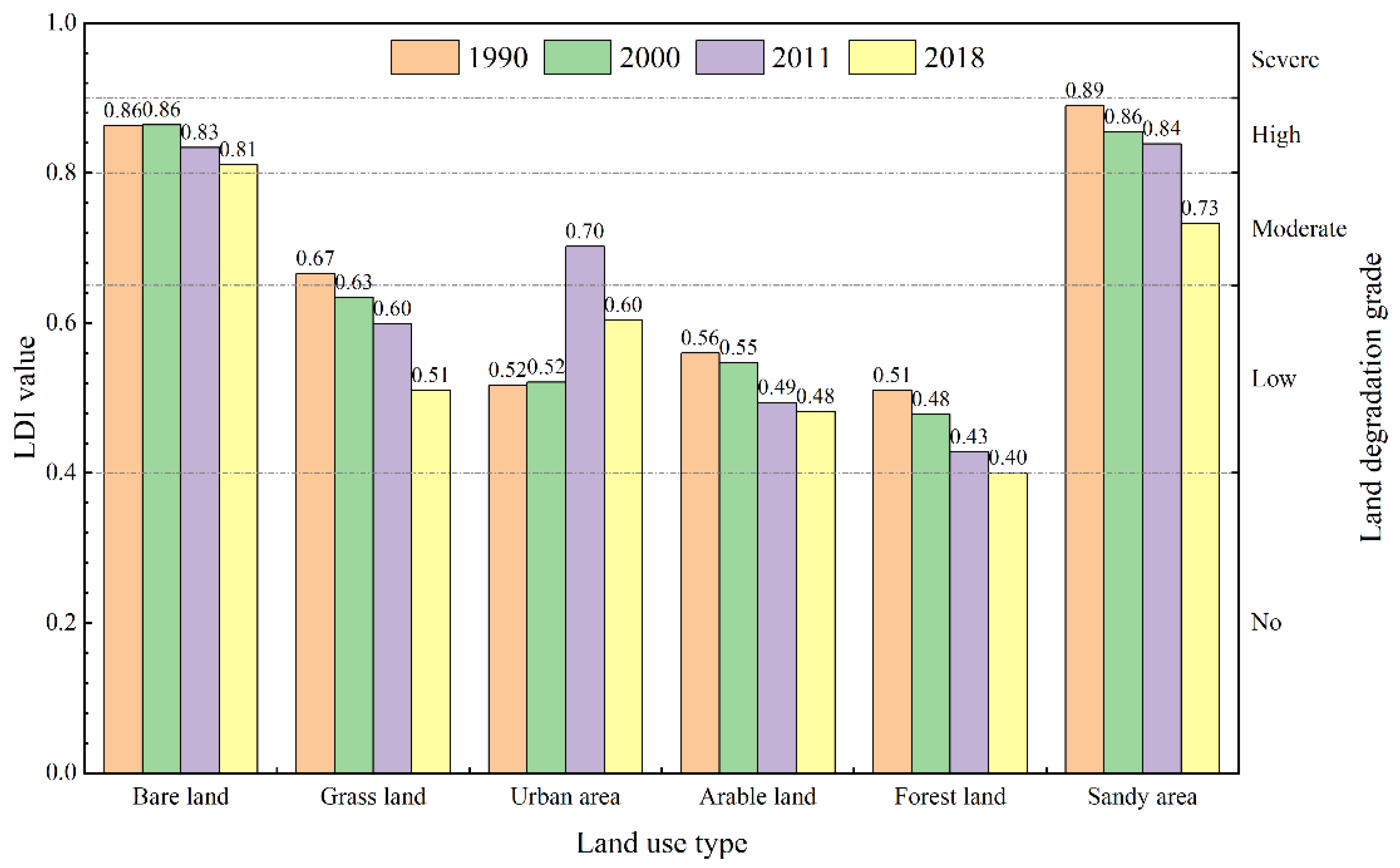
| Data | Time | Resolution | Data Sources |
|---|---|---|---|
| DEM | - | 30 m | Geomatics Center of Shaanxi Province |
| Land cover | 1990 | 30 m | Landsat 5 TM, 22 August |
| 2000 | 30 m | Landsat 5 TM, 23 July | |
| 2011 | 30 m | Landsat 5 TM, 10 September | |
| 2018 | 10 m | Resources and Environmental Sciences and Data Center, Chinese Academy of Sciences (Landsat 8 ETM) | |
| NDVI | 1990 | 30 m | Landsat 5 TM, 13 August and 11 September 1989 |
| 2000 | 30 m | Google Earth Engine | |
| 2011 | 30 m | Google Earth Engine | |
| 2018 | 30 m | Google Earth Engine | |
| Soil properties | 2017 | - | Field Sampling |
| Climate | 1979–2018 | - | China National Climate Center |
| Precipitation | 1990–2019 | 10 stations | Yellow River Water Resources Commission |
| Terrace | 2018 | 30 m | Field investigation |
| Factors | Min | Middle | Max |
|---|---|---|---|
| Vegetation cover (%) | 10 | 30 | 50 |
| Soil erosion rate (t km−2 a−1) | 5000 | 10,000 | 15,000 |
| Aridity index | 0.03 | 0.34 | 0.65 |
| Soil organic carbon content (g/kg) | 5 | 10 | 15 |
| Desertification index | 0.3 | 0.55 | 0.8 |
Publisher’s Note: MDPI stays neutral with regard to jurisdictional claims in published maps and institutional affiliations. |
© 2022 by the authors. Licensee MDPI, Basel, Switzerland. This article is an open access article distributed under the terms and conditions of the Creative Commons Attribution (CC BY) license (https://creativecommons.org/licenses/by/4.0/).
Share and Cite
Lu, A.; Tian, P.; Mu, X.; Zhao, G.; Feng, Q.; Guo, J.; Xu, W. Fuzzy Logic Modeling of Land Degradation in a Loess Plateau Watershed, China. Remote Sens. 2022, 14, 4779. https://doi.org/10.3390/rs14194779
Lu A, Tian P, Mu X, Zhao G, Feng Q, Guo J, Xu W. Fuzzy Logic Modeling of Land Degradation in a Loess Plateau Watershed, China. Remote Sensing. 2022; 14(19):4779. https://doi.org/10.3390/rs14194779
Chicago/Turabian StyleLu, Ang, Peng Tian, Xingmin Mu, Guangju Zhao, Qingyu Feng, Jianying Guo, and Wenlong Xu. 2022. "Fuzzy Logic Modeling of Land Degradation in a Loess Plateau Watershed, China" Remote Sensing 14, no. 19: 4779. https://doi.org/10.3390/rs14194779
APA StyleLu, A., Tian, P., Mu, X., Zhao, G., Feng, Q., Guo, J., & Xu, W. (2022). Fuzzy Logic Modeling of Land Degradation in a Loess Plateau Watershed, China. Remote Sensing, 14(19), 4779. https://doi.org/10.3390/rs14194779






